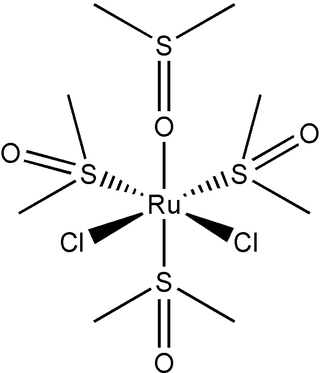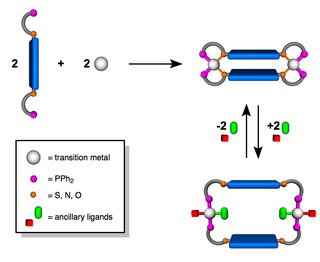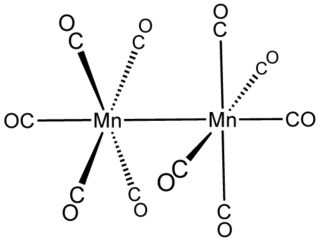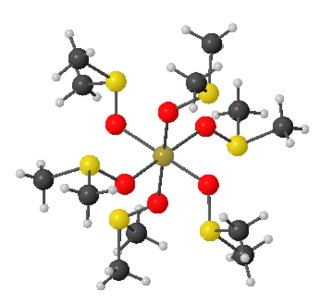![Structure of [Ru(NH3)5(SMeEt)] . RuA5(SMeEt)++ (KUFKIF).png](http://upload.wikimedia.org/wikipedia/commons/thumb/4/4b/RuA5%28SMeEt%29%2B%2B_%28KUFKIF%29.png/120px-RuA5%28SMeEt%29%2B%2B_%28KUFKIF%29.png)
Transition metal thioether complexes comprise coordination complexes of thioether (R2S) ligands. The inventory is extensive.
![Structure of [Ru(NH3)5(SMeEt)] . RuA5(SMeEt)++ (KUFKIF).png](http://upload.wikimedia.org/wikipedia/commons/thumb/4/4b/RuA5%28SMeEt%29%2B%2B_%28KUFKIF%29.png/120px-RuA5%28SMeEt%29%2B%2B_%28KUFKIF%29.png)
Transition metal thioether complexes comprise coordination complexes of thioether (R2S) ligands. The inventory is extensive.
As the simplest thioether, dimethyl sulfide forms complexes that are illustrative of the class. [2] Well characterized derivatives include cis-[TiCl4L2], VCl3L2, NbCl5L, NbCl4L2, Cr(CO)5L, CrCl3L3, RuCl2L4, RuCl3L3, RhCl3L3, cis- and trans-[IrCl4L3]-, cis-MCl2L2 (M = Pd, Pt), [PtCl3L]−, cis- and trans-[PtCl4L2] (L = SMe2). With respect to donor properties, dimethyl sulfide is a soft ligand with donor properties weaker than phosphine ligands. [3] Such complexes are generally prepared by treating the metal halide with the thioether. Chloro(dimethyl sulfide)gold(I) can however be prepared by redox reaction of elemental gold and DMSO in the presence of hydrochloric acid. [4]

Thioether complexes feature pyramidal sulfur centers. Typical C-S-C angles are near 99° in both free thioethers and their complexes. The C-S distance in dimethylsulfide is 1.81 Å, which is also unaffected in its complexes. [5] The stereochemistry of thioether complexes have been extensively studied. [6] Unsymmetrical thioethers, e.g., SMeEt, are prochiral ligands, and their complexes are chiral. One example is [Ru(NH3)5(SMeEt)]2+. The complex cis-VOCl2(SMeEt)2 exists as meso- and a pair of enantiomers. [7] In complexes of thioethers of the type S(CH2R)2 (R ≠ H), the methylene protons are diastereotopic. Examination of the NMR spectra of such complexes reveal that they undergo inversion at sulfur, without dissociation of the M-S bond. [8]

Unlike ethers, thioethers occasionally serve as bridging ligands. The complexes Nb2Cl6(SMe2)3 is one such example. It adopts a face-sharing bioctahedral structure with a Nb(III)=Nb(III) bond, spanned by two chloride and one dimethylsulfide ligands. The complex Pt2Me4(μ-SMe2)2 is a source of "PtMe2". [10]
Thiacrown ligands are analogous to crown ethers. The best studied thiacrown ligands have the formula (SCH2CH2)n (n = 3,4,5,6). The tridentate tri-thioether 9-ane-S3 forms extensive families of complexes of the type M(9-ane-S3)L3 and [M(9-ane-S3)2]2+. Examples of Cu(II)-thioether complexes were prepared from 14-ane-S4 [13] and 15-ane-S5. [11] The hexadentate ligand 18-ane-6 also forms extensive family of complexes, including unusual examples of Pd(III) and Ag(II). [14] Examples of homoleptic complexes [M(SR2)6]n+ are otherwise rare.
Thioether complexes in nature arise from coordination of the sulfur substituent found in the amino acid methionine. One of the axial ligands in cytochrome c is illustrative. Methionine sulfur weakly binds to copper in azurin.
In chemistry, linkage isomerism or ambidentate isomerism is a form of isomerism in which certain coordination compounds have the same composition but differ in their metal atom's connectivity to a ligand.

Dithiolene metal complexes are complexes containing 1,2-dithiolene ligands. 1,2-Dithiolene ligands, a particular case of 1,2-dichalcogenolene species along with 1,2-diselenolene derivatives, are unsaturated bidentate ligand wherein the two donor atoms are sulfur. 1,2-Dithiolene metal complexes are often referred to as "metal dithiolenes", "metallodithiolenes" or "dithiolene complexes". Most molybdenum- and tungsten-containing proteins have dithiolene-like moieties at their active sites, which feature the so-called molybdopterin cofactor bound to the Mo or W.

1,4,7-Trithiacyclononane, also called 9-ane-S3, is the thia-crown ether with the formula (CH2CH2S)3. This cyclic thioether is most often encountered as a tridentate ligand in coordination chemistry, where it forms transition metal thioether complexes.
In chemistry, a (redox) non-innocent ligand is a ligand in a metal complex where the oxidation state is not clear. Typically, complexes containing non-innocent ligands are redox active at mild potentials. The concept assumes that redox reactions in metal complexes are either metal or ligand localized, which is a simplification, albeit a useful one.

Dichlorotetrakis(dimethyl sulfoxide) ruthenium(II) describes coordination compounds with the formula RuCl2(dmso)4, where DMSO is dimethylsulfoxide. Both cis and trans isomers are known, but the cis isomer is more common. The cis isomer is a yellow, air-stable solid that is soluble in some organic solvents. These compounds have been extremely successful as an intermediate in the synthesis of various ruthenium(ii) complexes. They have also attracted attention as possible anti-cancer drugs.
Organoplatinum chemistry is the chemistry of organometallic compounds containing a carbon to platinum chemical bond, and the study of platinum as a catalyst in organic reactions. Organoplatinum compounds exist in oxidation state 0 to IV, with oxidation state II most abundant. The general order in bond strength is Pt-C (sp) > Pt-O > Pt-N > Pt-C (sp3). Organoplatinum and organopalladium chemistry are similar, but organoplatinum compounds are more stable and therefore less useful as catalysts.

Dichlorotris(triphenylphosphine)ruthenium(II) is a coordination complex of ruthenium. It is a chocolate brown solid that is soluble in organic solvents such as benzene. The compound is used as a precursor to other complexes including those used in homogeneous catalysis.

Chloro(dimethyl sulfide)gold(I) is a coordination complex of gold. It is a white solid. This compound is a common entry point into gold chemistry.

The Tolman electronic parameter (TEP) is a measure of the electron donating or withdrawing ability of a ligand. It is determined by measuring the frequency of the A1 C-O vibrational mode (ν(CO)) of a (pseudo)-C3v symmetric complex, [LNi(CO)3] by infrared spectroscopy, where L is the ligand of interest. [LNi(CO)3] was chosen as the model compound because such complexes are readily prepared from tetracarbonylnickel(0). The shift in ν(CO) is used to infer the electronic properties of a ligand, which can aid in understanding its behavior in other complexes. The analysis was introduced by Chadwick A. Tolman.

The Weak-Link Approach (WLA) is a supramolecular coordination-based assembly methodology, first introduced in 1998 by the Mirkin Group at Northwestern University. This method takes advantage of hemilabile ligands -ligands that contain both strong and weak binding moieties- that can coordinate to metal centers and quantitatively assemble into a single condensed ‘closed’ structure. Unlike other supramolecular assembly methods, the WLA allows for the synthesis of supramolecular complexes that can be modulated from rigid ‘closed’ structures to flexible ‘open’ structures through reversible binding of allosteric effectors at the structural metal centers. The approach is general and has been applied to a variety of metal centers and ligand designs including those with utility in catalysis and allosteric regulation.
Ruthenium anti-cancer drugs are coordination complexes of ruthenium complexes that have anticancer properties. They promise to provide alternatives to platinum-based drugs for anticancer therapy. No ruthenium anti-cancer drug has been commercialized.

Water oxidation catalysis (WOC) is the acceleration (catalysis) of the conversion of water into oxygen and protons:

cis-Dichlorobis(bipyridine)ruthenium(II) is the coordination complex with the formula RuCl2(bipy)2, where bipy is 2,2'-bipyridine. It is a dark green diamagnetic solid that is a precursor to many other complexes of ruthenium, mainly by substitution of the two chloride ligands. The compound has been crystallized as diverse hydrates.

(Terpyridine)ruthenium trichloride is the coordination complex with the formula RuCl3(terpy), where terpy is terpyridine. It is a brown paramagnetic solid that is a precursor to other complexes of ruthenium, mainly by substitution of the chloride ligands. The complex has octahedral geometry. The synthesis of this complex was reported for the first time in 1980, it was prepared by mixing ruthenium trichloride and terpyridine in ethanol, heating the mixture to reflux conditions A later synthetic protocol uses a similar approach by heating ruthenium trichloride with a DMF solution of terpyridine.
Niobium(III) chloride also known as niobium trichloride is a compound of niobium and chlorine. The binary phase NbCl3 is not well characterized but many adducts are known.

Transition metal pyridine complexes encompass many coordination complexes that contain pyridine as a ligand. Most examples are mixed-ligand complexes. Many variants of pyridine are also known to coordinate to metal ions, such as the methylpyridines, quinolines, and more complex rings.

In inorganic chemistry, metal–metal bonds describe attractive interactions between metal centers. The simplest examples are found in bimetallic complexes. Metal–metal bonds can be "supported", i.e. be accompanied by one or more bridging ligands, or "unsupported". They can also vary according to bond order. The topic of metal–metal bonding is usually discussed within the framework of coordination chemistry, but the topic is related to extended metallic bonding, which describes interactions between metals in extended solids such as bulk metals and metal subhalides.

In organic chemistry, thia-crown ethers are organosulfur compounds which are the thia analogues of crown ethers. That is, they have a sulfur atom in place of each oxygen atom around the ring. While the parent crown ethers have the formulae (CH2CH2O)n, the parent thia-crown ethers have the formulae (CH2CH2S)n, where n = 3, 4, 5, 6. They have trivial names "x-ane-Sy", where x and y are the number of atoms in the ring and the number of those atoms that are sulfur, respectively. Thia-crown ethers exhibit affinities for transition metals.
Transition metal complexes of 2,2'-bipyridine are coordination complexes containing one or more 2,2'-bipyridine ligands. Complexes have been described for all of the transition metals. Although few have any practical value, these complexes have been influential. 2,2'-Bipyridine is classified as a diimine ligand. Unlike the structures of pyridine complexes, the two rings in bipy are coplanar, which facilitates electron delocalization. As a consequence of this delocalization, bipy complexes often exhibit distinctive optical and redox properties.

A transition metal sulfoxide complex is a coordination complex containing one or more sulfoxide ligands. The inventory is large.